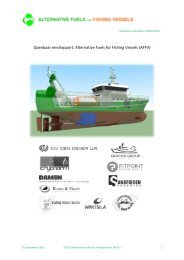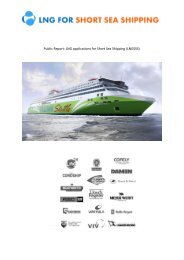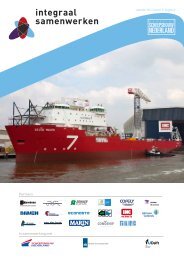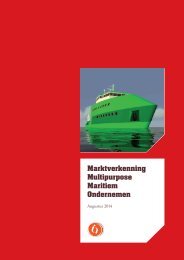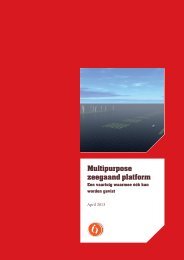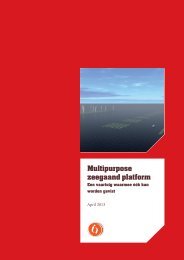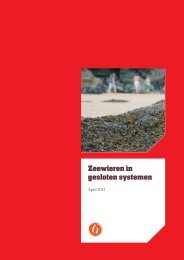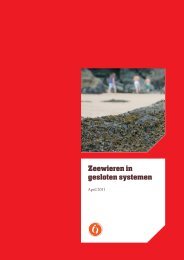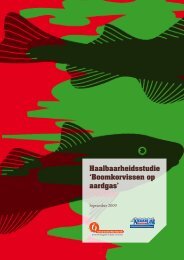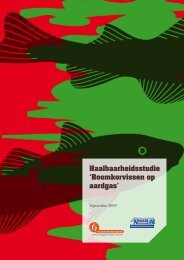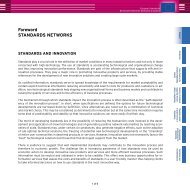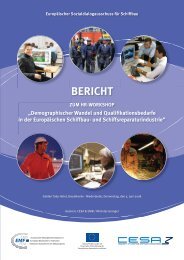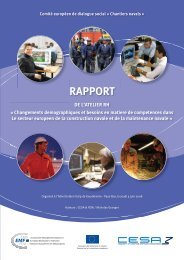Summary: Market Research Multipurpose Maritime Entrepeneurship (2014)
A market research into the possibilities to combine fishing activities with offshore and/or govermental services at sea.
A market research into the possibilities to combine fishing activities with offshore and/or govermental services at sea.
You also want an ePaper? Increase the reach of your titles
YUMPU automatically turns print PDFs into web optimized ePapers that Google loves.
Marktverkenning<br />
<strong>Multipurpose</strong><br />
Maritiem<br />
Ondernemen<br />
Augustus <strong>2014</strong>
Marktverkenning<br />
<strong>Multipurpose</strong><br />
Maritiem Ondernemen<br />
Dit rapport is in opdracht van InnovatieNetwerk opgesteld door:<br />
Pieter ’t Hart, Koers & Vaart B.V.<br />
Projectleider InnovatieNetwerk:<br />
Ir. J.A. Landstra<br />
Dit rapport is opgesteld in het kader van het thema ‘Noordzeevisserij’, concept<br />
‘<strong>Multipurpose</strong> Maritiem Ondernemerschap’.<br />
Postbus 19197<br />
3501 DD Utrecht<br />
tel.: 070 378 56 53<br />
www.innovatienetwerk.org<br />
Het ministerie van EZ nam het initiatief tot en financiert InnovatieNetwerk.<br />
ISBN: 978 – 90 – 5059 – 522 – 3<br />
Overname van tekstdelen is toegestaan, mits met bronvermelding.<br />
Rapportnr. 14.2.332, Utrecht, augustus <strong>2014</strong>.
<strong>Summary</strong><br />
43<br />
<strong>Multipurpose</strong> <strong>Maritime</strong> Entrepreneurship – Final Report on<br />
Exploratory <strong>Market</strong> Study<br />
Hart, Ir. P. ‘t, Koers & Vaart B.V.<br />
InnovationNetwork Report No. 14.2.332, Utrecht, The Netherlands,<br />
August <strong>2014</strong>.<br />
‘From Fisherman to <strong>Multipurpose</strong> <strong>Maritime</strong> Entrepreneur’ was one of<br />
the four long-term ambitions of the Fisheries Innovation Platform<br />
(2007-2011) – and it is still an ambition that InnovationNetwork is<br />
pursuing in the world of fisheries. The challenge is to broaden the<br />
fisheries business model to other seaborne activities and create a more<br />
diversified economic base.<br />
Earlier InnovationNetwork reports show that the most obvious solution<br />
for fishing vessels in the Dutch situation is to focus on private and<br />
public marine research and nearshore activities. Marine research generally<br />
yields a lower return than offshore activities for the gas, oil and<br />
green energy sector (wind turbines), but it is a fast-growing market<br />
and makes less demands on vessel and crew. The offshore market<br />
yields a higher return, but places higher demands on vessel and crew.<br />
For this reason, this market is also taken on board in this report.<br />
As part of the research entitled “<strong>Multipurpose</strong> seagoing platform – A<br />
vessel and fishing boat in one” (InnovationNetwork, 2013), a business<br />
case and calculation model were developed to help fisheries entrepreneurs<br />
form an initial idea of the costs and revenues given a specific<br />
combination of diverse maritime activities.
44 To further refine this business case and provide the arithmetical<br />
model with accurate data, the maritime consultancy Koers & Vaart B.V.<br />
– drawing on interviews with market parties, public sources research,<br />
and its knowledge of shipbuilding and maritime market segments –<br />
made an overview of the market segments, types of vessels, new shipbuilding<br />
prices, total costs, daily rates and returns for the various<br />
types of vessels and accompanying activities.<br />
Conclusions and recommendations<br />
<strong>Multipurpose</strong> maritime entrepreneurship not only calls for technological<br />
adjustments to ships and different competencies of the crew, but<br />
also new forms of entrepreneurship. Cooperation within the sector is<br />
also key to positioning the fisheries sector as an attractive provider of<br />
services and to build bargaining power vis-à-vis customers.<br />
Offshore support for oil & gas − including diving, seismic support and<br />
wind farm support − is a market with interesting opportunities for<br />
multipurpose seagoing platforms. The prices are good. High demands<br />
are made on ship, crew and technical systems. But the entry threshold<br />
is not as high as is often thought. One operational challenge is that<br />
most activities and the highest prices occur in the summer season,<br />
which is also the best fishing season.<br />
Technical systems such as Dynamic Positioning (DP), motion<br />
compensating (knuckle boom) cranes and offshore access systems<br />
absolutely offer added value in the offshore and wind farm support.<br />
The big question, however, is whether the utilization rate of these<br />
systems throughout the entire year justifies these investments.<br />
A seagoing platform that can facilitate diving support activities is an<br />
interesting option. The fishing vessel winches, for instance, can be<br />
used for four-point anchoring. However, the ship must have sufficient<br />
crane capacity and deck capacity to make this possible. Wind farm<br />
construction also offers opportunities for vessels without DP or other<br />
complex technical systems, including searching for unexploded ordinance<br />
(UXO) and other research activities.<br />
Though this market is significantly smaller, support activities for the<br />
government can also be profitable. The current austerity drive has made<br />
government more willing to cooperate with maritime businesses than<br />
before. The study also shows that such partnerships can yield substantial<br />
public cost savings thanks to the much more intensive use of units.<br />
The recommendation is to elaborate the multipurpose seagoing platform<br />
concept in consultation with potential new users into a concrete<br />
design with accompanying functional and technical specifications. As<br />
this report centres on the fisheries sector’s potential to develop new<br />
activities, fishing businesses are the only secured customer for the platform<br />
at this stage. This means that the investment cost-benefit analysis<br />
must fit in with normal fisheries operations.<br />
A long-term commitment of the new user makes it possible to adapt<br />
the design to his specific needs. An additional advantage is that this<br />
gives the ship owner greater security for the finance. This new user
can also become a co-investor in the new platform and can increase<br />
the platform’s annual capacity utilization rate.<br />
45<br />
Clear choices must be made at an early stage regarding crew requirements<br />
and the use of the platform. There is a tendency to want to use<br />
the multipurpose seagoing platform for all possible additional activities.<br />
In practice, however, the platform is more likely to be used for<br />
two or three additional activities over longer periods of time. This<br />
limits the retooling time and increases the annual capacity utilization<br />
rate.<br />
Support with offshore oil and gas activities is attractive to start with,<br />
because of the current large demand in this market segment. Looking<br />
further ahead, low-cost wind farm maintenance also seems a<br />
promising proposition because of the growing price pressure in this<br />
segment and the expected cost effectiveness of the platform.<br />
It was found that the offshore market offers scope for vessels with a<br />
length of 40 to 50 metres. The innovation challenge is to adjust the<br />
technology as currently installed on larger ships in an effective (and<br />
cost-effective) manner for relatively simple modular application on<br />
smaller ships. The recommendation therefore is to form partnerships<br />
with system integrators and suppliers of complex technical systems –<br />
such as cranes, winches, offshore access systems and propulsion<br />
systems – in order to look for alternative solutions for existing systems.<br />
A modular approach makes it possible to only install the technology<br />
necessary for the activity in hand, thus saving time and limiting the<br />
required deck space. This greatly improves the opportunities for using<br />
medium-sized vessels in the offshore segment and can further reduce<br />
the costs for end users.<br />
Finally, government must ensure that regulations and procedures are<br />
sufficiently accommodative to enable such new combinations of<br />
fishing activities with other operations. The responsible authorities<br />
have indicated their willingness to discuss appropriate measures.




